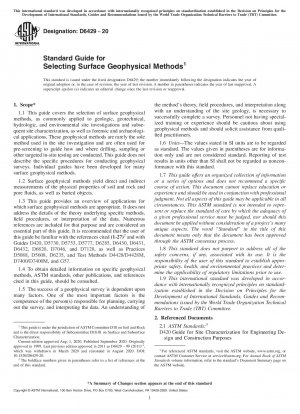ASTM D6429-20
Standard Guide for Selecting Surface Geophysical Methods
- Standard No.
- ASTM D6429-20
- Release Date
- 2020
- Published By
- American Society for Testing and Materials (ASTM)
- Status
- Replace By
- ASTM D6429-23
- Latest
- ASTM D6429-23
- Scope
- 1.1 This guide covers the selection of surface geophysical methods, as commonly applied to geologic, geotechnical, hydrologic, and environmental site investigations and subsequent site characterization, as well as forensic and archaeological applications. These geophysical methods are rarely the sole method used in the site investigation and are often used for pre-screening to guide how and where drilling, sampling or other targeted in-situ testing are conducted. This guide does not describe the specific procedures for conducting geophysical surveys. Individual guides have been developed for many surface geophysical methods. 1.2 Surface geophysical methods yield direct and indirect measurements of the physical properties of soil and rock and pore fluids, as well as buried objects. 1.3 This guide provides an overview of applications for which surface geophysical methods are appropriate. It does not address the details of the theory underlying specific methods, field procedures, or interpretation of the data. Numerous references are included for that purpose and are considered an essential part of this guide. It is recommended that the user of this guide be familiar with the references cited (1-27)2 and with Guides D420, D5730, D5753, D5777, D6285, D6430, D6431, D6432, D6820, D7046, and D7128, as well as Practices D5088, D5608, D6235, and Test Methods D4428/D4428M, D7400/D7400M, and G57. 1.4 To obtain detailed information on specific geophysical methods, ASTM standards, other publications, and references cited in this guide, should be consulted. 1.5 The success of a geophysical survey is dependent upon many factors. One of the most important factors is the competence of the person(s) responsible for planning, carrying out the survey, and interpreting the data. An understanding of the method’s theory, field procedures, and interpretation along with an understanding of the site geology, is necessary to successfully complete a survey. Personnel not having specialized training or experience should be cautious about using geophysical methods and should solicit assistance from qualified practitioners. 1.6 Units—The values stated in SI units are to be regarded as standard. The values given in parentheses are for information only and are not considered standard. Reporting of test results in units other than SI shall not be regarded as nonconformance with this standard. 1.7 This guide offers an organized collection of information or a series of options and does not recommend a specific course of action. This document cannot replace education or experience and should be used in conjunction with professional judgment. Not all aspects of this guide may be applicable in all circumstances. This ASTM standard is not intended to represent or replace the standard of care by which the adequacy of a given professional service must be judged, nor should this document be applied without consideration of a project’s many unique aspects. The word “Standard” in the title of this document means only that the document has been approved through the ASTM consensus process. 1.8 This standard does not purport to address all of the safety concerns, if any, associated with its use. It is the responsibility of the user of this standard to establish appropriate safety, health, and environmental practices and determine the applicability of regulatory limitations prior to use. 1.9 This international standard was developed in accordance with internationally recognized principles on standardization established in the Decision on Principles for the Development of International Standards, Guides and Recommendations issued by the World Trade Organization Technical Barriers to Trade (TBT) Committee.
ASTM D6429-20 Referenced Document
- ASTM D3740 Standard Practice for Minimum Requirements for Agencies Engaged in the Testing and/or Inspection of Soil and Rock as Used in Engineering Design and Construction
- ASTM D420 Standard Guide to Site Characterization for Engineering Design and Construction Purposes
- ASTM D4428/D4428M Standard Test Methods for Crosshole Seismic Testing*, 2024-04-21 Update
- ASTM D5088 Standard Practice for Decontamination of Field Equipment Used at Nonradioactive Waste Sites
- ASTM D5608 Standard Practice for Decontamination of Field Equipment Used at Low Level Radioactive Waste Sites
- ASTM D5730 Standard Guide for Site Characterization for Environmental Purposes With Emphasis on Soil, Rock, the Vadose Zone and Ground Water
- ASTM D5753 Standard Guide for Planning and Conducting Borehole Geophysical Logging
- ASTM D5777 Standard Guide for Using the Seismic Refraction Method for Subsurface Investigation
- ASTM D6235 Standard Practice for Expedited Site Characterization of Vadose Zone and Ground Water Contamination at Hazardous Waste Contaminated Sites
- ASTM D6285 Standard Guide for Locating Abandoned Wells
- ASTM D6430 Standard Guide for Using the Gravity Method for Subsurface Investigation
- ASTM D6431 Standard Guide for Using the Direct Current Resistivity Method for Subsurface Investigation
- ASTM D6432 Standard Guide for Using the Surface Ground Penetrating Radar Method for Subsurface Investigation
- ASTM D653 Standard Terminology Relating to Soil, Rock, and Contained Fluids
- ASTM D6639 Standard Guide for Using the Frequency Domain Electromagnetic Method for Subsurface Site Characterizations
- ASTM D6820 Standard Guide for Use of the Time Domain Electromagnetic Method for Geophysical Subsurface Site Investigation
- ASTM D7046 Standard Guide for Use of the Metal Detection Method for Subsurface Exploration*, 2024-04-21 Update
- ASTM D7128 Standard Guide for Using the Seismic-Reflection Method for Shallow Subsurface Investigation
- ASTM D7400/D7400M Standard Test Methods for Downhole Seismic Testing
- ASTM G57 Standard Test Method for Field Measurement of Soil Resistivity Using the Wenner Four-Electrode Method
ASTM D6429-20 history
- 2023 ASTM D6429-23 Standard Guide for Selecting Surface Geophysical Methods
- 2020 ASTM D6429-20 Standard Guide for Selecting Surface Geophysical Methods
- 1999 ASTM D6429-99(2011)e1 Standard Guide for Selecting Surface Geophysical Methods
- 1999 ASTM D6429-99(2006) Standard Guide for Selecting Surface Geophysical Methods
- 1999 ASTM D6429-99 Standard Guide for Selecting Surface Geophysical Methods
